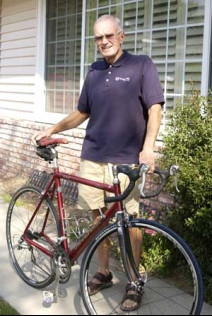California Cyclist Pushes Back Against Mesothelioma
John Russell was born September 6, 1935, in Chicago. His father worked as a retail manager for Florsheim Shoes in Chicago, just around the corner from the Biograph Theater, where bank robber and fugitive John Dillinger was gunned down by FBI agents in 1934. The family moved to Hermosa Beach in 1938.
John's mother suffered from chronic pneumonia, and died from chronic heart disease when he was nine. John's family moved to the Valley before the war in 1942. His father was a manager at the Friedman Shelby shoe store. He later worked as the West Coast sales rep for L.B. Evans men's shoes.
After his mother's death, John lived in an orphanage until age 16, when his father re-married. He attended four different high schools, graduating in 1953 from Burroughs. He attended two semesters at Hollywood High, where the auditorium's stage curtain was made of asbestos cloth and had giant lettering that spelled out "Asbestos" on the curtain. "Do asbestos you can" was the unofficial school motto.
When John worked as a young man delivering automotive parts in Los Angeles, he had no idea that the brake pads being arced in his company's machine shop contained lethal asbestos. Daily surrounded by the poisonous dust, the effects of this early work led to his later development of mesothelioma.
In March, 2007, John developed tightness throughout his chest. An avid road cyclist who logs about 100 miles per week and who rides regularly with a local group, John had an EKG, blood test, and x-rays to determine whether he had a pulled rib muscle. The tests came back negative but he was treated as if he had a pulled rib.

A few weeks later John pulled a tendon in his foot, which required a cast that took him out of commission for six weeks. During that time he could not exercise or ride his bike. After the cast was removed, he began to recondition due to the extended period of inactivity. He had no problem riding long distances on flat surfaces, but found that he could no longer climb on his bike. Shortly thereafter he began experiencing shortness of breath when walking up stairs. Due to his exceptional physical condition and his particular cycling forte of being able to climb steep hills, he became concerned.
On October 2, 2007 John had 1.5 liters of fluid drained from around his lung, and 2 additional liters the following week. John then underwent a talc pleurodesis to prevent further fluid accumulation. During this procedure, the doctors performed a tissue biopsy. The pathology report confirmed epithelial-type malignant pleural mesothelioma.
John met with an oncologist who gave John a pamphlet from the NCI that said chemotherapy was the only treatment option, and asserted that neither surgery nor radiation were possible. The doctor based his opinion on the approximately twenty mesothelioma cases he has treated, "a few" of which he categorized as successes. John decided to seek a second opinion.

He and Esther looked into Dr. David Sugarbaker's mesothelioma program and learned that they would need to travel to Boston in order to get an answer about his suitability for treatment. Their daughter Cindy began doing research on the Internet and learned about Dr. Robert Cameron and the mesothelioma program at UCLA. After reading about Dr. Cameron's surgery with Kermit Kelley, they contacted PHLBI and asked about consulting with Dr. Cameron.
John, Esther, his daughter Cindy, his son Jeff, and his daughter in-law met with Dr. Cameron on October 30, and John had pleurectomy/decortication surgery in late November.
Surgery
Dr. Cameron completed the pleurectomy/decortication in 6.5 hours, and said it went as expected. The tumor was wrapped around the aorta but not attached to it and Dr. Cameron completely removed it. The lung suffered a few small nicks and the tumor covered half the diaphragm, with Dr. Cameron removing all gross tumor. John had follow up radiation, also at UCLA, as part of Dr. Cameron's multimodal therapy.
John had no pain from the cancer or the surgery, but drainage problems required him to take a lot of painkillers. He has lost 30-35 pounds and is having difficulty gaining it back, though he's eating about 3,000 kcal per day. Whatever setbacks come his way, John is certain to keep fighting with the help of his family, doctors, and friends.
*** POSTED OCTOBER 14, 2008 ***
*** Mr. John Russell passed away on November 15, 2008 ***

